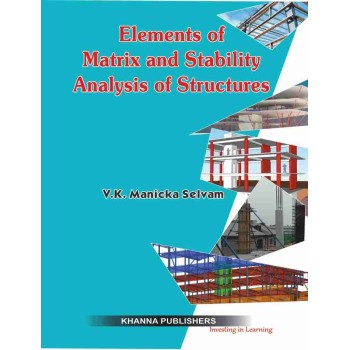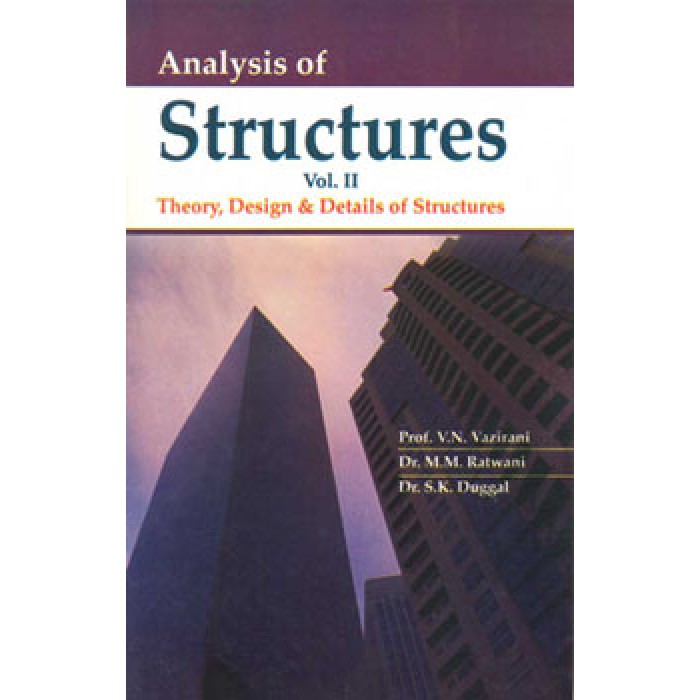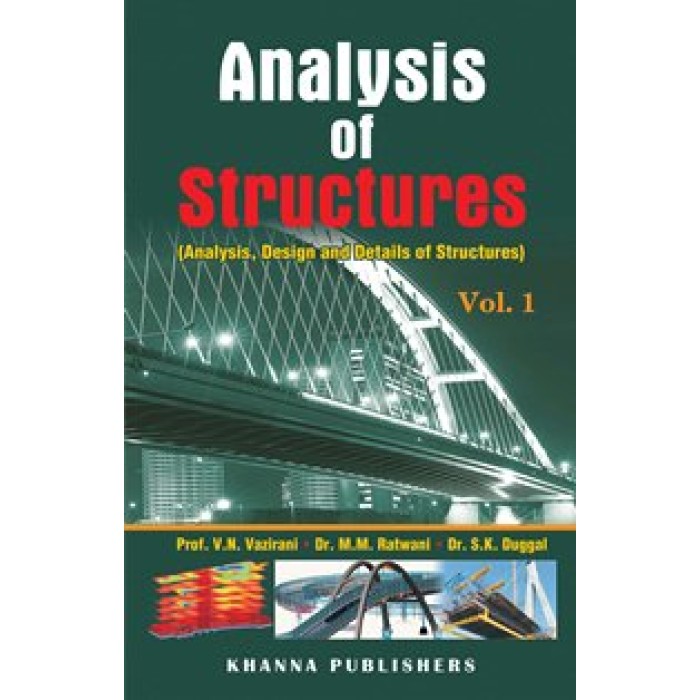Elements of Matrix and Stability Analysis of Structures
- Author V.K. Manicka Selvam
- ISBN: 978-81-7409-316-5
- ₹ 459.00
-
₹ 367.20
| Book Detail | |
| Publication Year | 1998 |
| ISBN-13 | 978-81-7409-316-5 |
| ASIN | 81-7409-316-8 |
| Language | English |
| Edition | 8th |
| Pages | 1436 |
| Preface | |
| Preface | The text consists of two subject matters, viz., Matrix Analysis of Structures and the Theory of Structural Stability, its principles and applications. Advent of computer paved way for the discovery of two novel methods, namely, Matrix Analysis and Finite Element Method. Because of these two methods, the conventional Slope Deflection, Moment Distribution, Column Analogy, Elastic Center, Kani's Method, Naylor's method, etc., will either go into desuetude or will be taught to a limited extent in the curriculum. In this text, the Matrix Analysis is dealt within an exhaustive manner serving as a prelude to comprehend and appreciate the more powerful FEM in the postgraduate course. Almost all structures include in them compression elements. In beams, part of the section is under compression. When the components are slender and thin, they have a tendency for buckling due to compression.In this text many novel formulations have been included to determine the critical loads of non-prismatic columns, square, rectangular and circular plates, elastic frames, rings, etc. These approximate theories are simple in concept, easy to work with and efficacious. Because of this fact, old and rigorous approximate procedures will be dispensed with in future. The subject matter advanced in this text may provide an effective background to develop new theories related to neural networks, genetic algorithm, biomechanics, |
| Table of Contents | |
| Table of Contents | Part-I *Statical Indeterminacy *Degree of freedom *Solution of equations *Sign convention *Energy method for establishing stiffness matrices *Equivalent joint loads *Computation of reactions Part-II *Basic concepts of matrix analysis of structures *Deflections of determinate structures *A) Integral Approach Using Flexibility Coefficients for finding Deflections of Beams subjected to Continuous Loading (2007) B) Work Method for Finding Maximum Deflection in Cantilever Beams (2007) C) Collateral Method of Real Work D) Matrix method for Finding ∆max and ᴓmax of Cardinal Structure E) Potential Energy Concept for Finding ∆max and ᴓmax of Cardinal Sturcture (2007) F) The CRC Method for Finding ∆max and Ømax of Cardinal Structure G) The Rayleigh Ritz Model for Finding ∆max and Ømax of Cardinal Structure (2007) H) Extentsion of Clapeyron’s Theorem For Finding ∆max and Ømax of Cardinal Structure I) Potential Energy Method for Finding ∆max and Ømax of Cardinal Structure J) External Work Equivalence for Finding ∆max and Ømax of Cardinal Structure K) Clapeyron’s Method for Finding ∆max and Ømax of Cardinal Structure L) Moments Approach for Finding ∆max and Ømax of Cardinal Structure. *Statically indeterminate system *Stress due to lack of fit and temperature *Displacement method of analysis *Direct stiffness method *Frames with sloping members *Grid analysis *Stiffness matrix through potential energy *Unstable elements *Conventional Rayleigh-Ritz Method (CRRM-1908) *Improved Rayleigh-Ritz Method (RRM-1994) *Additional information on Rayleigh-Ritz Method *Central deflection of simply supported beams *Central deflection of fixed beams *Special problems Part-III *Introduction *The Euler columns *Simple stability problems *Generation of shape functions *Double integration method *Single integration method(1997) *Centre of gravity method *Method of weighted moment of inertia *Lower bound solution for non-prismatic Euler columns *Upper bound solution for Euler columns *Work method for Euler columns *Total Moment Concept (TMC) for Finding Critical Loads *SE. Best Lower and Upper Bound Solutions for Critical Loads *Triple Integration Method for Non-prismatic Euler Columns *Moment integration concept * Equivalent Moment oflnertia Concept Using Second Moment Equation *Equivalent Moment oflnertia Method for Group-B Columns *Slope and Deflection Comparison Method *Method of successive approximation *Timoshenko's energy method *A. Energy Method *B No Derivative Method (Equivalent Column Method) * C lOC. Euler's Energy Method *D. Moment Equilibrium Method for Euler Columns *Prismatic Column Approach for Non-Prismatic Columns *11. The Galerkin Method 12. Finite Difference Method 13. imperfect Approach 14. Empirical formulae for column Design 15. Effect of Shearing Force on the Critical Load 16. Beam-Columns 17. Stability Functions 18. Single Joint Method (SJM) 19. Energy Method of Finding Critical Loads of Frames 20. Buckling of thin Plates 21.Post Buckling of Plates Torsional Buckling 23.Real Work and Principle of Virtual Displacement 24.Critical loads of plates using the Energy Method (1997) 25. Improved Energy Method for Finding the Critical Load of Non sway Frames Hinged at the Bottom 26. Buckling of Thin Rings 27. Applications of Potential Energy Concepts Columns (1998) 28. Stodola's Method. *Applications of potential energy concepts columns (1998) *Stodola's method *Questions and answers in Structural engineering *Auxiliary stability functions *Distinct stability functions *Solved exercises *Intuitive Problems *Model Question Paper & Its Solution *Appendices *References |
Related Products
Analysis of Structures Vol-II (Theory, Design & Details of Structures)
(Theory, Design and Details of Structures)..
₹ 359.20 ₹ 449.00 Ex Tax: ₹ 359.20
Analysis of Structures Vol-I (Analysis, Design and Details of Structures)
(Analysis, Design and Details of Structures)..
₹ 439.20 ₹ 549.00 Ex Tax: ₹ 439.20



